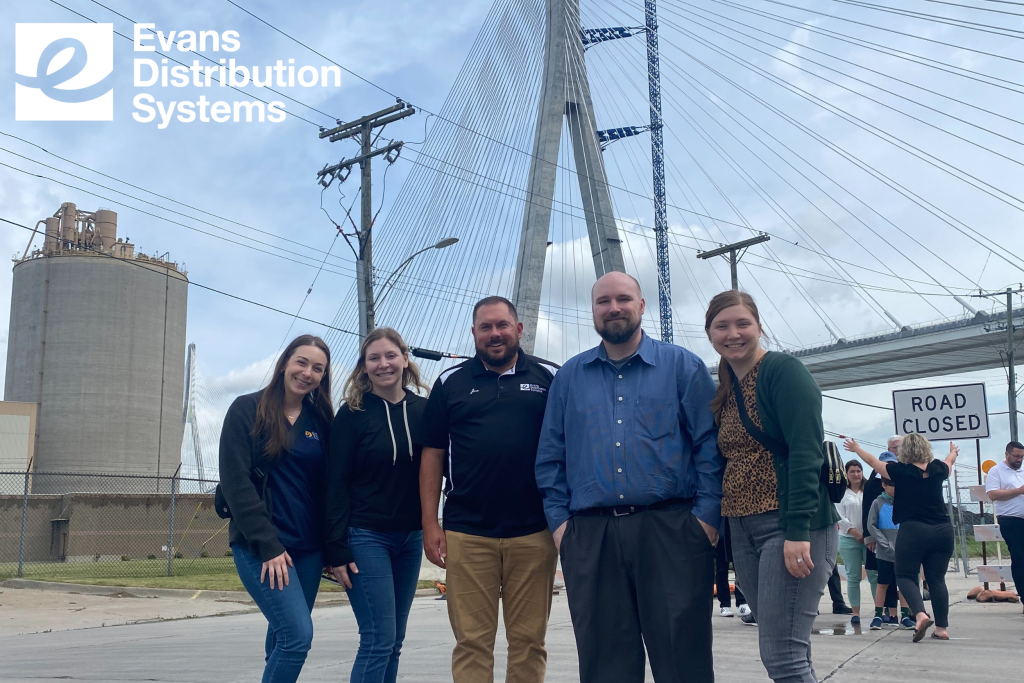
The Evans team recently had the exciting opportunity to visit the Gordie Howe International Bridge as it nears the final stages of construction. This landmark project represents a major leap forward in infrastructure, trade, and cross-border connectivity between the U.S. and Canada. Our visit, hosted by the Council of Supply Chain Professionals (CSCMP) Greater Lakes Roundtable, gave us a firsthand look at the innovations being implemented and the lasting benefits the bridge will bring to the Detroit-Windsor region. Here’s what we learned.
A Closer Look at the Project
The Gordie Howe International Bridge project includes four main components: the bridge, the U.S. Port of Entry (POE), the Canadian POE, and the Michigan Interchange. Once completed, the bridge will feature six lanes of vehicle traffic along with pedestrian and bicycle pathways on both sides, offering a more inclusive and accessible travel experience.
The Canadian POE will include 24 primary inspection lanes, while the U.S. POE will house 36, allowing for more efficient customs processing. Both facilities will also include onsite government agencies to assist with inspections and streamline the border-crossing process for commercial and passenger vehicles. In addition to addressing long-standing transportation needs, the project also promises significant benefits in job creation, international trade, and community development across the Windsor-Detroit corridor.
Innovation at Every Turn
Compared to the Ambassador Bridge, the Gordie Howe International Bridge is a major step forward in terms of safety, speed, and smart technology. It’s built to support modern-day transportation, particularly designed to minimize bottlenecks and traffic delays experienced by the trucking industry. The bridge and its ports of entry will feature dedicated truck lanes, to separate commercial traffic from passenger vehicles and improve flow and safety. Driver-friendly road lights will support visibility during long hauls, and safety features have been built in to accommodate truck breakdowns quickly and with minimal disruption to traffic.
An onsite weather monitoring station will allow for real-time updates and early warnings of poor conditions, helping travelers make informed decisions. Additional innovations include travel time detection systems to monitor and report border wait times, intelligent video systems that detect unauthorized movement near trucks, and video feeds to support real-time traffic monitoring. Trucking companies will also benefit from geofencing capabilities and integrated supply chain security programs. Together, these systems will create a smarter, safer, and more responsive border crossing for all users.
Environmental and Community Impact
It’s clear that this bridge is more than just an infrastructure project; it’s a comprehensive investment in the environment and the surrounding communities. Environmental sustainability has been built into every phase. For example, Bridging North America, the consortium managing the project, is also constructing five new pedestrian bridges across I-75, a six-foot-wide protected cycle track along Fort Street, and continuous, fully accessible sidewalks between the service drives and the I-75 mainline. These elements ensure safer and more connected travel for residents.
Both the Canadian and U.S. Ports of Entry are being built to meet at least a LEED v4 Silver rating, reflecting high environmental and energy-efficiency standards. The bridge and Michigan Interchange also received the Envision Platinum Award from the Institute for Sustainable Infrastructure—the highest honor available for sustainable infrastructure design and construction.
Enhancing Detroit and Windsor
From the beginning, project planners recognized that the Gordie Howe International Bridge was an opportunity to generate lasting social and economic benefits. A robust Workforce Development and Participation Strategy was created to maximize community involvement and job growth. This strategy includes more than 80 programs focused on employment training, job readiness, apprenticeships, mentorship, and educational outreach. It targets a diverse range of participants, from students and tradespeople to small business owners and underrepresented communities, including Indigenous Peoples.
The project also includes direct investments in the communities most affected by construction, namely, Sandwich in Windsor and Delray in Detroit. Through the Neighborhood Infrastructure Strategy, more than CAD 23 million has been committed to projects that enhance quality of life in these neighborhoods. Since 2019, over 60 local initiatives have been supported, including green space improvements, trail development, lighting upgrades, public art installations, small business assistance, and cultural preservation efforts. These enhancements reflect a thoughtful approach to building not just a bridge, but a better, more connected region.
Looking Ahead
The Gordie Howe International Bridge is expected to open in the fall of 2025, and the Evans team is excited to witness the technology and innovations come to life. This bridge is more than steel and concrete, it’s a symbol of progress, collaboration, and shared growth between two nations. We look forward to the new opportunities it will bring to our region and to the future of international logistics and transportation.
